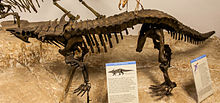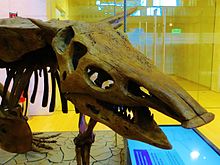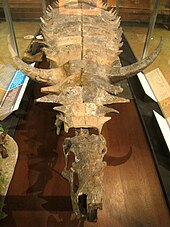Desmatosuchus
| Desmatosuchus | |
|---|---|

| |
| Desmatosuchus from Petrified Forest National Park, Arizona | |
| Scientific classification | |
| Domain: | Eukaryota |
| Kingdom: | Animalia |
| Phylum: | Chordata |
| Class: | Reptilia |
| Clade: | Archosauria |
| Clade: | Pseudosuchia |
| Order: | †Aetosauria |
| Family: | † Stagonolepididae
|
| Subfamily: | †Desmatosuchinae |
| Genus: | †Desmatosuchus Case, 1920 |
| Type species | |
| †Desmatosuchus spurensis Case, 1921
| |
| Species | |
| |
| Synonyms | |
| |
Desmatosuchus (
Description

Desmatosuchus was a large quadrupedal reptile measuring 4.5 m (15 ft) to over 5 m (16 ft) long and weighing about 280–300 kg (620–660 lb).

Its skull was relatively small, on average about 37 centimeters long, 18 centimeters wide, and 15 centimeters high. The braincase was very firmly fused with the skull roof and palate. It had slender, forked
Individuals of Desmatosuchus were heavily armored. The carapace was made up of two rows of median scutes surrounded by two more rows of lateral scutes. The lateral scutes had well-developed spine-like processes which pointed out laterally and dorso-posteriorly.[7] There were typically five rows of spines, increasing in size anteriorly. The front spine was much larger, around 28 centimeters long, and was recurved. The fourth spine varies in length in each specimen, but remains shorter than the fifth in all of them.[2] Desmatosuchus are the only aetosaurs known to have possessed spines like these.[7]
Discovery and classification
The first Desmatosuchus discovery occurred in the late 19th century when E.D. Cope classified armor from the Dockum Group in Texas, USA, as the new species Episcoposaurus haplocerus.[8] Case later classified a partial skeleton found in the Tecovas Formation as Desmatosuchus spurensis.[9] Since the localities of Cope and Case were only a few kilometers apart, the two taxa were synonymized into Desmatosuchus haplocerus, the initial type species of the genus.[8]
A revision of Desmatosuchus by Parker (2008) found the
The following cladogram is simplified, after an analysis presented by Julia B. Desojo, Martin D. Ezcurra and Edio E. Kischlat (2012).[11]

| Aetosauria |
| ||||||||||||||||||||||||||||||||||||||||||||||||||||||||||||||||||||||||||||||||||||||||||
Paleobiology

Bones and armor pieces of Desmatosuchus are abundant in the Dockum formation, Chinle formation, and Post quarry, indicating that they were widespread and abundant during the Late Triassic.[2] It is possible that Desmatosuchus traveled in herds or family units. This is evidenced by several findings of multiple Desmatosuchus skeletons in relatively small areas.[2]
Desmatosuchus had blunt, bulbous, slightly recurved teeth. Furthermore, they are believed to have had

The armor and spikes of Desmatosuchus were its only ways to defend itself from predators. The lateral spike rows showed variation in size among individuals, especially the second most anterior spike. This spike was always shorter than the one in front of it, but to what extent varied drastically. This variation may indicate sexual dimorphism.[7] It has also been hypothesized as a form of sexual display.[2] Aside from this armor, Desmatosuchus was defenseless from attacks from carnivores. Several Desmatosuchus bones have been found amongst skeletons of Postosuchus, indicating predation by Postosuchus.[2] The herd nature of Desmatosuchus apparently did little to discourage predators, as Postosuchus along with several other Late Triassic carnivores also traveled in groups.[2]
Most thecodonts of the Late Triassic lacked certain pelvic features that aided locomotion, such as a deep acetabulum or a crest over the acetabulum. This, in spite of their upright posture, rendered them only slightly more mobile than sprawling reptiles.[13] Desmatosuchus possessed both of these features, along with its long femur and elongate pubis, making it more mobile than most thecodonts of its time.[13] This mobility, along with its size, abundance, and specialized beak made it the chief herbivore in the Dockum area.[2]
It has also been suggested that Desmatosuchus could have been omnivorous or even an insectivore. This is because of several similarities between Desmatosuchus and
References
- .
- ^ hdl:2346/19710.
- ^ von Baczko, M. B., Desojo, J. B., Gower, D. J., Ridgely, R., Bona, P., & Witmer, L. M. (2021). New digital braincase endocasts of two species of Desmatosuchus and neurocranial diversity within Aetosauria (Archosauria: Pseudosuchia). The Anatomical Record, 1–20. https://doi.org/10.1002/ar.24798
- ISBN 9781862393615. Retrieved 14 September 2022.)
{{cite book}}: CS1 maint: multiple names: authors list (link - ISSN 1932-8486.
- ^ OCLC 844318914.
- ^ ISBN 1-84028-152-9.
- ^ S2CID 85826683.
- Yale Peabody Museum: 1–27.
- ^ Parker, William G. (12 May 2008). "Description of new material of the aetosaur Desmatosuchus spurensis (Archosauria: Suchia) from the Chinle Formation of Arizona and a revision of the genus Desmatosuchus". PaleoBios. 28 (1). University of California Museum of Paleontology: 1–40.
- ISSN 1175-5334.
- ^ JSTOR 2992601.
- ^ PMID 28564788.
- ^ .
